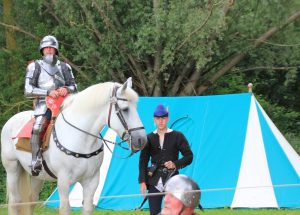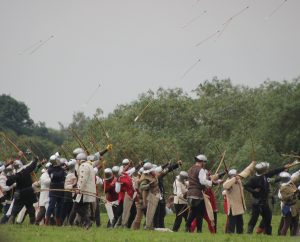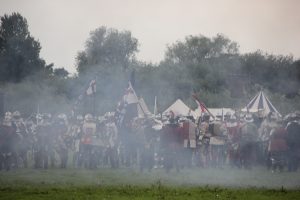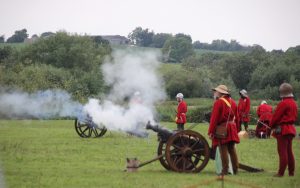Our project’s PhD student Helene Benkert has been on another mission to infiltrate the world of medieval re-enactment. This time it took her to Tewkesbury Medieval Festival, one of the largest gatherings of its kind in Europe.
Thousands of enthusiasts gather each year on the fields near Tewkesbury Abbey, the very same fields where on 4 May 1471 the Lancastrian army was defeated by the Yorkist contingent, to relive this critical battle. Stalls and tents of re-enactors from all over Europe are scattered across the area and swarmed by excited visitors.
Just like the big Easter Jousting Event at Leeds, Tewkesbury’s Medieval Festival draws a huge crowd. It seems, hitting each other with sticks – whether lances or swords, on horse or on foot – is as popular as ever. At least, they have cut back on the blood that gave The Bloody Meadow its name.
While this event is mostly horse-free – there is a single mounted knight with a stunning Percheron-type grey, aptly named ‘King’ – there would have been plenty of equids in the original battle, whether for combat or transport.
 In lieu of the actual horses, the ‘Warhorse’ project acts as their ambassador at Tewkesbury. Armed with posters, flyers and real horse bones from Exeter’s reference collection I go about my mission to draw people into the world of medieval warhorses. And people are most willing to follow the lure.
In lieu of the actual horses, the ‘Warhorse’ project acts as their ambassador at Tewkesbury. Armed with posters, flyers and real horse bones from Exeter’s reference collection I go about my mission to draw people into the world of medieval warhorses. And people are most willing to follow the lure.
After a fabulous day of chatting with many wonderfully engaged and interested people about our project and horses in general it is time for the Big Event, the re-enactment of the Battle of Tewkesbury. Narrated like a modern football game, we watch the drama unfold as several hundred re-enactors in full armour and armed with lances and swords charge at each other in a rain of arrows and the smoke of large guns. It truly is a spectacle and the audience dutifully holds their breath and cheers at the appropriate moments.

 For the final skirmish, re-enactors and visitors alike make their way through Tewkesbury town and to the abbey. The conclusive beheadings are accompanied by much cheering and laughter (perhaps not too much unlike the real ones some 600 years ago) and followed by friend and (revived) foe joining each other for a pint or many.
For the final skirmish, re-enactors and visitors alike make their way through Tewkesbury town and to the abbey. The conclusive beheadings are accompanied by much cheering and laughter (perhaps not too much unlike the real ones some 600 years ago) and followed by friend and (revived) foe joining each other for a pint or many.
It’s wonderful to see so many people interested in history and a town so invested in its own past. As much as importance is placed on authenticity, the feeling of community and integrity within the accurate historical settings is just as valuable.
Next year, we will be back to represent medieval warhorses. We will happily share our newest research and chat about horses. There will also be fun activities for old and young alike, so do pop by and say hello.
